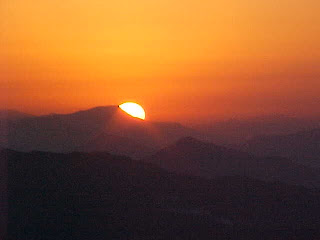 |
| remote village of palpa |
Palpa (a historical place) is in Lumbini zone, named for the birthplace of Guatama Buddha. Palpa's high hills command an impressive view of
Nepal in all directions with the great
Madi Valley in the west and the
Kali Gandaki River along its northern border. Palpa is made up on sixty-five VDC areas and a municipality and a population of around 240 thousand people. The district, withTansen as its headquarters, covers an area of 1,373 km². It is situated at the southern slope of the Mahabhrat range, and the
Himalayas. The main religion of the people of Palpa is Hinduism followed by Buddhism. There are also Muslims and Christians in small communities. Tansen was the capital of the Palpa kingdom ruled by the Sen Dynasty, before
Nepal was united,. The history of Tansen dates back to the 16th century. Prithvi Narayan Shah, who united
Nepal, mother was from the Sen Family. For years the Gorkha and Palpa kingdoms were in alliance and combined them took control of western
Nepal. In 1806, Prithivipal Sen, the last king of Palpa, was asked to come to
Kathmandu and he was beheaded. Palpa became parted of the
Kathmandu kingdom and Tansen became the administrative city for the area. Members of the Shah and Rana family have ruled the region.
+of+palpa_tansen.jpg) |
| view of tansen |
At an elevation of about 1350-m (4430 ft) above sea level palpa experiences a pleasant climate throughout the year.
There are many places in palpa district which are quite interesting for visitors in terms of scenary and historical importance.I would like to maintain few places which shouldn’t be missed.
Tansen is a hill town, enterprising Newar traders and craftspeople and the rich culture of the Magar people and other groups who make up the town and area's population combine to make Tansen unique in
Nepal. With views of the Himalaya from Shreenagar and rich natural environment all around, Tansen is one of the most scenic places in
Nepal. As a gateway to Palpa and surrounding areas, it offers access to Palpa's variety and character of rural life, small towns, religious and historical sites. Though it boasts a busy market and is a centre in
Western Nepal and the headquarters of the Palpa district, Tansen is quiet and pollution free.
Kathmandu Valley and Tansen are much closer in their character: Newari houses, cobbled streets, Rana buildings, pagoda temples etc.
 |
| view from srinagar |
 |
| Mul dhoka |
 |
| damaged darbar after maoist atatck |
An ancient hill town Tansen-1350 meters above sea level is the administrative headquarters of Palpa district. It is a typical Nepali town with numerous fairs, festivals, religious and cultural events. The name Tansen has been derived from the Magar language tansing-means the northern settlement. Magars in Palpa district and Newars in Tansen town inhabit in majority and there are also Chhetris and Brahamins and others.
 |
| panoromic view |
Tansen is the best and nearest hill station of west
Nepal and northern states of
India due to its location and climate. There are great views of the
Madi Valley from town. From the close by hill call Srinagar Danda, there are excellent views of the
Himalaya Mountains. The climate of Tansen is most pleasant throughout the year. In summer it stays mild and charming-hardly exceeds 28° degree Celsius. In winter it is quite warm and sunny -the temperature does not fall near freezing. Tansen Durbar was the palace of the provincial governor built in the Rana style. It has an impressive but run-down eastern gate called ‘Baggi Dhoka’ or ‘Mul Dhoka’. Outside the gate is a public square called ‘Sitalpati’. General Pratap Shamsher built this palace in 1927 AD. It is a four-storied building with sixty-three rooms, two meeting halls, and two minarets at two sides. The main gate of this palace is known as 'Baggi Dhoka' the biggest gate in the Kingdom. The ‘Durbar’ is known as a 'Singh Durbar of Palpa". But this ‘Durbar’ and ‘Mul Dhoka’ is affected during the war with Maoists last year and is now again started to reconstruct. Other attraction of tansen is a traditional three-tiered pagoda-style
temple Amar Narayan Temple built in 1806. It is considered to be one of the most beautiful temples outside of
Kathmandu Valley. The temple was built by Amar Singh Thapa, who annexed Tansen to become part of
Nepal.
 |
| Bhagwati temple |
Bhagawati Temple near the Tansen Durbar, was originally built in 1815 to commemorate the victory over the British at Butwal. In the area there are small temples dedicated by Ganesh, Saraswati and Siva. It was rebuilt by Col. Ujir Singh Thapa, the governor of Palpa in 1815 A.D. to commemorate the victory over British Indian troop in the battle front of Butwal. The
temple of
God Ganesh called siddhi Binayak, is situated at the slope of
srinagar hill just above the town. Devotees visit this temple on every Tuesday. One can have a very good view of the town from here.
 |
| amar narayan temple |
‘Srinagar Danda’ is a 1600m high hill just north of Tansen, from where there are excellent views over the
Kali Gandaki River of the
Himalaya. We can see
Annapurna and Langtang in the east. The 1650 meter high majestic ridge covered with dense pine forest in the south slope and natural vegetation with the National flower 'Rhododendron' in the
North Slope is popular for naturalist. During a clear day, a magnificent view of long range of snowy mountains to the north and the vast expanse of Terai plains to the south can be seen. This provides unbroken peace and relaxation.
 |
| night view of tansen |
The green view of hills around is very enchanting, beautiful and calm. The tranquil
Srinagar forest is equally pleasant. A bird’s eye view of Tansen with the green and plain
Madi Valley on the background can be enjoyed. It is only the place from where one can see the vast expanse of Terai plains to the south and the long range of snowy mountains to the north. The main snowy peaks seen from here are Dhaulagiri : I- 8167 mtrs., Nilgiri-7061 mtrs.,
Annapurna: I-8091 mtrs., Hinchuli-6441 mtrs., Machhapuchhare-6997 mtrs., Manaslu-8157 mtrs., Ganesh Himal etc.
 |
| shitalpati |
Ranighat palace is built by Khadga Shamsher JBR in 1894 AD., on monument of deep love with his queen Tej Kumari. It is very nice palace with the architectural point of view. It is built above a single huge stone near by Kaligandaki river. Ranimahal is popularly pronounced as ‘Tajmahal’ of
Nepal. Here is the 2nd largest suspension bridge of
Nepal and ‘Alamdevi Mandir’ across the river. ‘Siddapani cave’, ‘Hattidhunga’-huge elephant shaped stone, ‘Baikunthapahar’ - water falls, are on the way form Tansen.
 |
| way to ranighat |
+of+3333036170_f7de8d0ccc_z.jpg) |
| rani mahal |
 |
| view of ranimahal with kaligandaki |
 |
| View of bridge in ranighat |
Bhairavsthan is the most popular temple in Palpa and also throughout the nation. Situated at 5 km North-west of Tansen on the Palpa-Gulmi, this temple also has the largest ‘Trishul’- a symbol of God Shiva, of
Asia. Every year during the Dashain, the greatest festival of Hindus of Nepal, people from different places come here to worship the god- ‘Bhairav’ and show homage by paying Him the blood of five different cattle- known as ‘Panchabali.’
 |
| Trishul of bhairabsthan temple |
Ridi is one of the historical places of Palpa. Situated at about 20 Km. north-west from the Palpa Headquarters – Tansen, it is also the place where the
Ridi River and
Kali Gandaki River meet. There is a popular Pagoda-style Rishikesh Mandir, thus contributing to the place being a pilgrimage site. In 1st Magh(15th January) every year, pilgrims from different corners of
Nepal come here to take sacred bath in the river and then pay homage at the temple. Local people and businessman, some others from neighboring districts come to participate in a 3-day fair held during the same occasion. Transactions of local rugs (‘Kamlo’) brought from Jumla and Humla districts are one of the features in the fair.
 |
| Ridi |
Madan Pokhara is a highly prosperous village near Tansen. This beautiful valley is also culturally rich and has many temples that pilgrims can visit. The popular temples are Kalanki Devi, Devisthan and Mandabya. Madan Pokhara is linked to sidhhartha highway.
 |
| View from madan pokhara |
.
Tahu is another attractive village with mixed culture and beautiful natural surroundings of mountains, forests and farmlands. One can also see beautiful views of mountains from here. There are also temples of Rambha Devi and Jalpa Devi in Tanahu. It is 32 kilometers from Tansen and can be entered from Aarya bhanjyang of
Siddhartha Highway  |
| Rambha devi temple |
Satyawati Lake, at 1,400 meters takes its name from Goddess Satyawati from the Hindu mythology and is a popular pilgrimage site in the area. It is equally attractive for other tourists considering that the trek is enjoyable and the destination worth visit. One can enjoy beautiful views of
Himalayas on the way to the lake. The trek starts at siddhartha highway, about 19 kilometers from Tansen, from where it takes about 2-hour trek uphill to reach
Lake Satyawati.It is believed that one shouldn’t stay till the morning near satyawati lake during mela pver there. One should ask the blessing with loud noise as it supposed that satyati devi can’t hear properly.
.jpg) |
| satyawati lake |
Chilangdi, a typical Magar village offers cultural taste of the area. The people of Chilangdi are simple and have a charming lifestyle. Singing and dancing are the main part their lives. They speak Tibeto-Burman language. Chilangdi is situated at the southern lap of Shreenagar Hills.
Other places to see in pala are pravash lake, ramdi ghat, siddhababa cave,elephant hill(locally called hatti lek), kaudi hill(locally called kaudi lek)
 |
| View of madi phant |
Palpa is popular for:
Bronze craft (Palpali Karuwa), is famous for various kinds of handicrafts and cottage industries. One of the most famous products of this district is a typical water-jug called Karuwa. It is made of bronze and available in different sizes. In Tansen, Taksar is the main area where the art of bronze crafting is still flourishing. People visiting Palpa are always eager to buy a Karuwa as a souvenir.
.jpg) |
| palpali karuwa |
Palpali Dhaka, is quiet famous handloom industry and gained national and international fame. It needs skill and hard labor to weave this cloth. Similarly the Palpali Dhaka Topi (cap) has become a part or our national dress. There are several products of these clothes;
Dhaka topis, shawls, purses etc. can be bought as a souvenir.
 |
| Dhaka topi |
Chukauni: traditional spicy cusine made with curd and potato.
Palpa is a also for different festivals like gai jatra, bhagwati jatra etc.
.jpg) |
| ramdi ghat |















+of+palpa_tansen.jpg)









+of+3333036170_f7de8d0ccc_z.jpg)






.jpg)

.jpg)

.jpg)


















.JPG)





